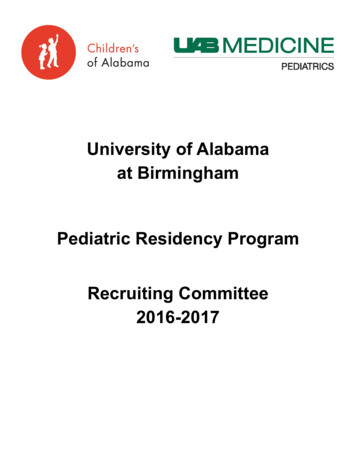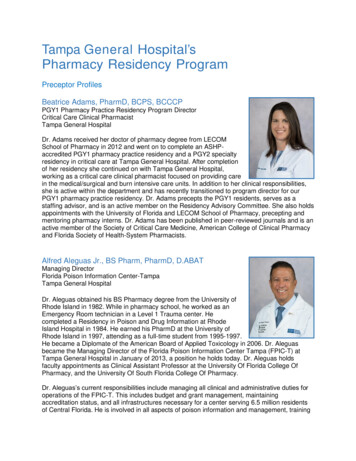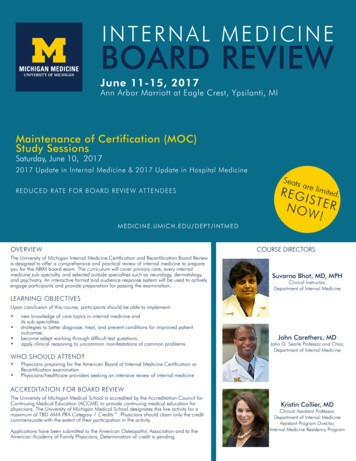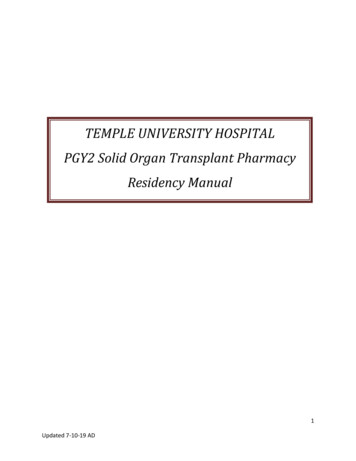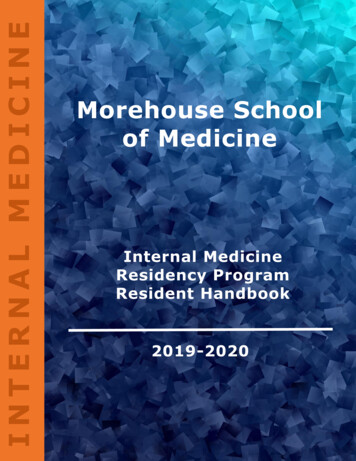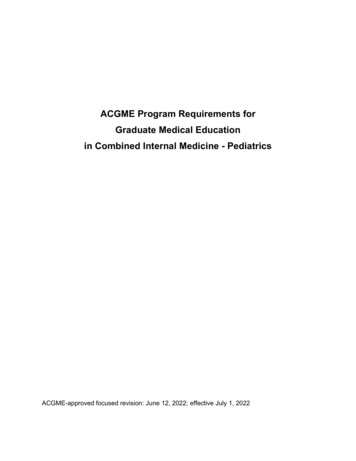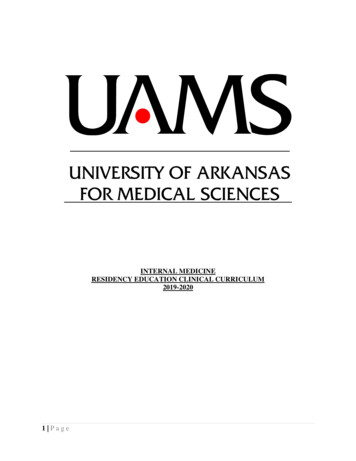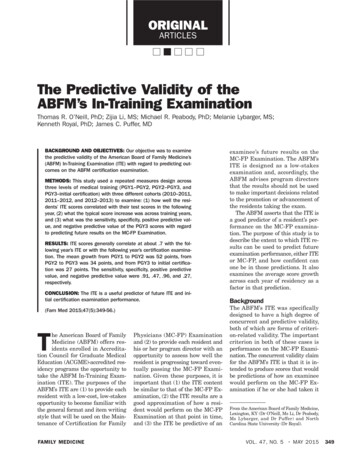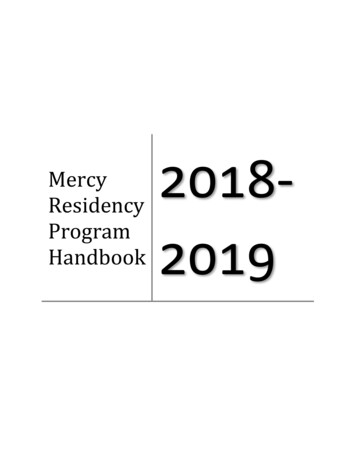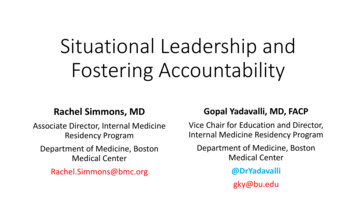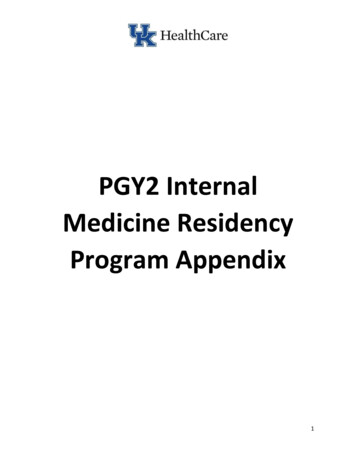
Transcription
PGY2 InternalMedicine ResidencyProgram Appendix1
PGY2 Internal Medicine Pharmacy Residency Purpose StatementPGY2 pharmacy residency programs build on Doctor of Pharmacy (PharmD) education and PGY1 pharmacyresidency programs to contribute to the development of clinical pharmacists in specialized areas of practice. PGY2residencies provide residents with opportunities to function independently as practitioners by conceptualizing andintegrating accumulated experience and knowledge and incorporating both into the provision of patient care orother advanced practice settings. Residents who successfully complete an accredited PGY2 pharmacy residencyare prepared for advanced patient care, academic, or other specialized positions, along with board certification, ifavailable.Residency DescriptionThe University of Kentucky Chandler Medical Center is a large academic medical center with 100 internalmedicine patients across a variety of medicine teams ( 10 teams) including traditional academic teaching teams,hospitalist/non-rounding teams, and BOOST (Better Outcomes for Optimizing Safe Transitions) teams/hospitalistrounding teams. The variety in internal medicine teams gives the resident training and experience in a multitudeof team structures, allowing for a seamless transition to clinical practice at any hospital structure.Each resident will be required to complete 6 months in general internal medicine and 1 month each in cardiology,pulmonary/MICU, and infectious diseases. Clinical expertise in subspecialty areas will be available through 3months of elective rotations, longitudinal research, and longitudinal ambulatory care clinic experience. Theinternal medicine resident participates in 24-hour clinical pharmacy services through the in-house on-call programand clinical staffing. Precepting students on advanced pharmacy practice experiences and didactic settings isoffered.Residents will have exposure to a broad array of disease states, with significant exposure to liver disease(s),including acute liver failure, alcoholic hepatitis, cirrhosis management (of all etiologies: nonalcoholicsteatohepatitis, cryptogenic, alcoholic, viral), and complications of cirrhosis. Graduates of our PGY2 internalmedicine residency program will be equipped to take on a clinical pharmacist position in an academic medicalcenter or community hospital and/or faculty position.Program Goals To develop the personal and professional skills necessary to serve as a pharmacotherapy specialist and anintegral member of an adult internal medicine health care team.To develop future leaders in clinical pharmacy practice and education.To prepare individuals to contribute to the body of pharmacotherapy and pharmacy practice knowledge.To develop clinical and teaching skills through involvement in didactics, small group facilitation, andadvanced pharmacy practice experience precepting.To encourage and help prepare the resident to seek certification as a Board Certified PharmacotherapySpecialist (BCPS) upon completion of the specialty residency.2
Required Learning Experiences and Learning Experience SelectionPGY2 Internal Medicine Residency Required Learning ExperiencesInternal Medicine 7 months--5 months academic teams--2 months non-academic teams (hospitalist nonrounding month,hospitalist rounding month)Cardiology 1 monthInfectious Diseases 1 monthPulmonary/Critical Care 1 monthLongitudinal ambulatory care clinicLongitudinal clinical staffingLongitudinal research projectFormal ACPE-accredited grand rounds presentationThe internal medicine resident works with the PGY2 internal medicine RPD to create his/her learning experienceschedule. Individual preferences are taken into account. Beginning the 2019-2020 residency year, five of the 6Internal Medicine experiences will be lumped into 3 blocks of 2 calendar months for continuity July/August,November/December (combined as one experience with same preceptor), and May/June. The required nonmedicine months and elective rotations will be scheduled based on other preceptor availability and scheduling ofother residents.The longitudinal ambulatory care clinic experience begins in August and lasts the duration of the residency year.The experience can either be a half-day every week or a full day every other week, depending on the resident’spreference and availability of clinic staff.The resident has 3 months of elective learning experiences, and the below list is an example of potential optionsbut is not necessarily exhaustive. If the resident has a particular interest, an additional learning experience can becreated to accommodate, pending availability of the service line, preceptor staff, and scheduling of otherresidents.PGY2 Internal Medicine Residency Elective Learning ExperiencesAcademia 1 monthAntimicrobial stewardship 1 monthKidney/liver transplant 1 monthMedical oncology 1 monthNeurology / stroke 1 monthNutrition support 1 monthObstetrics (OB) 2 weeksPalliative care 1 monthPsychiatry 1 month (can be modified to 2 weeks if requested)Surgery oncology 1 monthContact daysNo more than 3 vacation days per rotation experience can be granted off in additional to other resident obligations(i.e. post-call days, research days, professional leave days). Additional vacation days can be requested pendingRPD and/or direct preceptor approval, pending the rotation experience involved and other days off service during3
the same time frame. This ensures there is a fruitful rotation experience for the resident, while allowing forvacation leave as per the Leave Policy – Pharmacy Residents, PH09.03.005.Policy #PH09.03.005Clinical Staffing ShiftsBeginning the 2020-2021 residency year, the internal medicine staffs every 3rd weekend (Saturday and Sunday0730-1600) (averaged throughout the residency year), covering multiple internal medicine teams in a moreclinical-type setting (patient review, order verification, therapeutic drug monitoring, etc). This is in line with theother residency programs’ weekend staffing shift requirements. The weekend clinical staffing shifts are compiledwith night call and weekend call shifts from the in-house on-call program and are deducted from a total of 47staffing shifts, as suggested as the maximum number of staffing shifts per year per ASHP. The staffing shift deficit,if there is one, is then addressed by having the internal medicine resident pick up medicine evening shifts and/oradditional weekend shifts at his/her leisure, but these must be completed before the end of the residency year.Research ProjectResearch days are allocated in each month to permit the resident to have intermittent focus on the researchproject and facilitate meeting deadlines set forth by the individuals involved in the research. Research days shouldbe identified and planned with each learning experience preceptor prior to the start of each month. Typically, thepreceptor or affiliated clinical team members provide clinical cross-coverage while the resident is off service onresearch days. The PGY2 internal medicine resident is allotted 1 research day per non-internal medicine monthsand 2 research days per internal medicine months.The internal medicine resident is encouraged to present their PGY2 research at a professional meeting. Amanuscript suitable for publication is due at the end of June to the RPD and individuals involved in the researchproject.Policy #PH09.03.0804
PGY2 Internal Medicine Resident Goals and Objectives (2017 edition)Competency Area R1: Patient CareGoal R1.1 In collaboration with the health care team, provide safe and effective patient care tointernal medicine patients following a consistent patient care process.Objective R1.1.1 Interact effectively with health care teams to manage internal medicinepatients’ medication therapy.Objective R1.1.2 Interact effectively with internal medicine patients, family members, andcaregivers.Objective R1.1.3 Collect information on which to base safe and effective medicationtherapy for internal medicine patients.Objective R1.1.4 Analyze and assess information on which to base safe and effectivemedication therapy for internal medicine patients.Objective R1.1.5 Evaluate biomedical literature in the management of internal medicinepatients’ medication therapy.Objective R1.1.6 Design or redesign safe and effective patient-centered therapeuticregimens and monitoring plans (care plans) for internal medicine patients.Objective R1.1.7 Ensure implementation of therapeutic regimens and monitoring plans(care plans) for internal medicine patients by taking appropriate follow-up actions.Objective R1.1.8 For internal medicine patients, document direct patient care activitiesappropriately in the medical record or where appropriate.Objective R1.1.9 Demonstrate responsibility to internal medicine patients.Competency Area R2: Advancing Practice and Improving Patient CareGoal R2.1 Demonstrate ability to manage formulary and medication-use processes for internalmedicine patients, as applicable to the organization.Objective R2.1.1 Prepare or revise a drug class review, monograph, treatment guideline, orprotocol related to care of internal medicine patients.Objective R2.1.2 Participate in medication event reporting and monitoring related to carefor internal medicine patients.Objective R2.1.3 Identify opportunities for improvement of the medication-use systemrelated to care for internal medicine patients.Objective R2.1.4 Manage aspects of the medication-use process related to formularymanagement for internal medicine patients.Objective R2.1.5 Contribute to the work of an organizational committee or work groupconcerned with the improvement of medication use policies or guidelines.Goal R2.2 Demonstrate ability to conduct a quality improvement or research project.Objective R2.2.1 Identify or refine a specific project topic to improve patient care ofinternal medicine patients, or a topic for advancing internal medicine pharmacy practice.Objective R2.2.2 Develop a plan or research protocol for a practice quality improvement orresearch project for the care of internal medicine patients, or a topic for advancing thepharmacy profession or internal medicine pharmacy practice.Objective R2.2.3 Collect and evaluate data for a practice quality improvement or researchproject for the care of internal medicine patients or for a topic for advancing the pharmacyprofession or internal medicine pharmacy practice.5
Objective R2.2.4 Implement quality improvement or research project to improve care ofinternal medicine patients or implement an idea/project intended to advance thepharmacy profession or internal medicine pharmacy practice.Objective R2.2.5 Assess the implemented project and determine whether changes arerequired.Objective R2.2.6 Effectively develop and present, orally and in writing, a final project orresearch report suitable for publication related to care for internal medicine patients or fora topic for advancing the pharmacy profession or internal medicine pharmacy practice at alocal, regional, or national conference.Competency Area R3: Leadership and ManagementGoal R3.1 Demonstrate leadership skills for successful self-development in the provision of care forinternal medicine patients.Objective R3.1.1 Demonstrate personal, interpersonal, and teamwork skills critical foreffective leadership in the provision of care for internal medicine patients.Objective R3.1.2 Apply a process of ongoing self-evaluation and personal performanceimprovement in the provision of care for internal medicine patients.Goal R3.2 Demonstrate management skills in the provision of care for internal medicine patients.Objective R3.2.1 Contribute to internal medicine departmental management.Objective R3.2.2 Manage one’s own internal medicine practice effectively.Competency Area R4: Teaching, Education, and Dissemination of KnowledgeGoal R4.1 Provide effective medication and practice-related education to internal medicine patients,caregivers, health care professionals, students, and the public (individuals and groups).Objective R4.1.1 Design effective educational activities related to internal medicine.Objective R4.1.2 Use effective presentation and teaching skills to deliver education relatedto internal medicine.Objective R4.1.3 Use effective written communication to disseminate knowledge relatedto internal medicine.Objective R4.1.4 Appropriately assess effectiveness of education related to internalmedicine.Goal R4.2 Effectively employ appropriate preceptor roles when engaged in teaching students,pharmacy technicians, or fellow health care professionals in internal medicine.Objective R4.2.1 When engaged in teaching related to internal medicine, select apreceptor role that meets learners’ educational needs.Objective R4.2.2 Effectively employ preceptor roles, as appropriate, when instructing,modeling, coaching, or facilitating skills related to internal medicine.6
Requirements for successful completion of internal medicine pharmacy residencyPGY2 core goalsFor successful residency completion, residents must meet the following requirements.CompletionDateRequirementGraduate of ACPE-accredited college of pharmacyLicensure in the state of KentuckyActive certification from American Heart Association as ACLS providerComplete all staffing requirementsComplete ACPE-accredited Grand Rounds presentationComplete all assigned on-call shifts with documentation of on-call reportComplete Scholarship of Teaching and Learning Certificate Program, if notecompleted during PGY1 yearComplete College of Pharmacy teaching requirements Didactic lecture Laboratory facilitation – 8 hours (or equivalent experience)Achieved for Residency for required competency areas, goals R1-4 Goal R1.1 In collaboration with the health care team, provide safe andeffective patient care to internal medicine patients following a consistentpatient care process. Goal R2.1 Demonstrate ability to manage formulary and medication-useprocesses for internal medicine patients, as applicable to the organization. Goal R2.2 Demonstrate ability to conduct a quality improvement or researchproject. Goal R3.1 Demonstrate leadership skills for successful self-development inthe provision of care for internal medicine patients. Goal R3.2 Demonstrate management skills in the provision of care for internalmedicine patients. Goal R4.1 Provide effective medication and practice-related education tointernal medicine patients, caregivers, health care professionals, students,and the public (individuals and groups). Goal R4.2 Effectively employ appropriate preceptor roles when engaged inteaching students, pharmacy technicians, or fellow health care professionalsin internal medicine.Participate in all steps for at least one project [research or quality improvement] tomeet the PGY2 Internal Medicine goals and objectives (with manuscript suitable forpublication)7
PGY2 Internal Medicine Residency PreceptorsPreceptor NameAdams, AimeeAllen, KatherineBlackburn, ErinBurgess, DonnaCain, JeffreyDonaldson, ChrisHunt, TaylorJohnson, HannahKunka Fritz, MeganLeung, NoelleMeans, LauraMitchell, MeganNestor, MelissaPijut, KyleRendulic, TrisAnnSchenk, AshleyThompson Bastin, MelissaUttal-Veroff, KelseyWallace, KatieWoodward, BarbaraLearning Experience(s) PreceptedRequired or Elective?Longitudinal ambulatory care clinicRequiredInternal MedicineRequiredInternal MedicineRequiredInfectious DiseasesRequiredAcademiaElectivePulmonary/Critical CareRequiredInternal MedicineRequiredPsychiatryElectiveInternal ative careElectiveNeurology/strokeElectiveInternal MedicineRequiredKidney/Liver ical CareRequiredInternal MedicineRequiredInfectious DiseasesRequiredNutrition SupportElectiveRequired Learning Experiences and Learning Experience Selection8
Required Internal Medicine Rotations (6 months)Internal Medicine I – Introduction to Internal Medicine/Teaching team experience IInternal Medicine II – Teaching team experience IIInternal Medicine III – Teaching team experience IIIInternal Medicine IV – Hospitalist rounding experienceInternal Medicine V – Hospitalist non-rounding experienceInternal Medicine VI – Teaching team experience IVDatePlanned TopiccompletedInternal Medicine I – Introduction to Internal MedicineDirect PatientCareTopicDiscussionDiabetes mellitus, Type 1*Diabetes mellitus, Type 2*Syndrome of inappropriate antidiuretic hormone secretion*Thyroid disorders*Adrenal gland disorders (adrenal insufficiency,hypercortisolism)Hyperglycemic crises (diabetic ketoacidosis [DKA],hyperosmolar hyperglycemic state [HHS])Parathyroid disordersCirrhosis, end-stage liver disease, and complications (e.g.,portal hypertension, ascites, spontaneous bacterial peritonitis,varices, hepatic encephalopathy, hepatorenal syndrome)*Constipation*Diarrhea (including traveler’s diarrhea)*Hepatitis (including viral)*Inflammatory bowel disease (Crohn’s disease, ulcerativecolitis)*Nausea/vomiting, simple (e.g., acute viral gastroenteritis,overindulgence, motion sickness)*Nausea & vomiting, complex (e.g., postoperative,chemotherapy-induced)*Pancreatitis (acute, chronic, and drug-induced)*Upper gastrointestinal bleeding*Gastroesophageal reflux diseaseMotility disordersInternal Medicine IIAnemias (e.g., iron deficiency, vitamin B12 deficiency, folicacid deficiency, chronic disease/inflammation)*Drug-induced hematologic disorders*Reversal of anticoagulants*Coagulation disorders (e.g., hemophilia, von Willebranddisease, antiphospholipid syndrome, clotting factordeficiencies)Disseminated intravascular coagulationPlatelet disorders (e.g., idiopathic thrombocytopenic purpura,thrombotic thrombocytopenic purpura)9
Sickle cell diseaseAcid-base disorders*Acute kidney injury (prerenal, intrinsic, and postrenal)*Drug dosing considerations in renal dysfunction and renalreplacement therapy*Drug-induced renal disorders*Electrolyte abnormalities (sodium, potassium, calcium,phosphorus, magnesium)*Evaluation of renal function*Chronic kidney disease and complications (anemia, bone &mineral disorders)Dialysis and renal replacement therapiesInternal Medicine IIIMedication use in older adults (e.g., polypharmacy, potentiallyinappropriate medications [PIMs], Beers Criteria, dose deesc)*RhabdomyolysisEpilepsy*Neurocognitive disorders (e.g., Alzheimer disease, vascularand frontotemporal dementia)*Pain, neuropathic (e.g., diabetic, post-herpetic)*Pain, nociceptive (acute and chronic)*Parkinson disease*Peripheral neuropathy*Status epilepticusInternal Medicine IVAsthma*Chronic obstructive airway disease (other than asthma)*Overweight and obesity*Nutrition supportInternal Medicine VOncologic emergencies (e.g., tumor lysis syndrome,hypercalcemia, coagulopathy)*Supportive care (e.g., preventing/ treating complicationsassociated with malignancy or treatment, myelosuppression,nausea/vomiting, pain, mucositis, secondary malignancies)*Internal Medicine VIAlcohol use disorder*Anxiety disorders (e.g., generalized anxiety, panic, socialanxiety disorder)*Depressive disorders (e.g., major depressive disorder)*Delirium/acute agitation (non-ICU)*Opioid use disorder*Sleep disorders (e.g., insomnia. See other sleep-wakedisorders in Neurologic Disorders section)*Tobacco/nicotine use disorder (including smoking cessation)*10
Bipolar disorders (e.g., mania, bipolar depression,maintenance therapy)SchizophreniaSubstance abuse (e.g., hallucinogens, stimulants,depressants, performance-enhancing drugs)CardiologyAcute coronary syndromes (STEMI, NSTEMI, unstableangina)*Atrial arrhythmias*Atherosclerotic cardiovascular disease, primary prevention*Atherosclerotic cardiovascular disease, secondaryprevention*Cardiogenic/hypovolemic shock*Heart failure, acute decompensated & chronic*Hypertensive crises*Stroke (ischemic, hemorrhagic, and transient ischemicattack)*Venous embolism and thrombosis*Advanced Cardiac Life Support (ACLS)Basic Life Support (BLS)Peripheral arterial (atherosclerotic) diseasePulmonary arterial hypertensionValvular heart diseaseVentricular arrhythmiasCritical CareDrug/alcohol overdose/withdrawal*Pharmacokinetic and pharmacodynamic considerationsStress ulcer prophylaxisInfectious DiseasesAntimicrobial stewardship and infection prevention*Bloodstream and catheter-related infections*Bone and joint infection (e.g. osteomyelitis, prosthetic jointinfections)*Central nervous system infections (e.g. meningitis,encephalitis, brain abscess)*Fungal infections, invasive (e.g. hematogenous, candidiasis,aspergillosis)*Gastrointestinal infections (e.g. infectious diarrhea, C. difficile,enterotoxigenic infections)*Human immunodeficiency virus infection*Infective endocarditis*Infections in immunocompromised patients (e.g. febrileneutropenia, opportunistic infections in AIDS)*Influenza virus infection*Intra-abdominal infections (e.g. peritonitis, abscess,appendicitis, etc)*Lower respiratory tract infections*Sepsis and septic shock*Skin and soft tissue infections*11
Tuberculosis*Urinary tract infections (complicated and uncomplicated)*Bacterial resistanceFungal infections, superficial (e.g., vulvovaginal andesophageal candidiasis, dermatophytoses)Immunizations (including vaccines, toxoids, and otherimmunobiologics)Microbiological testing (including rapid diagnostic tests)Longitudinal ambulatory care clinic rosisRheumatoid arthritisBenign prostatic hyperplasia*Urinary incontinence*Those items marked with an (*) must be met through direct patient care experiences per ASHP. Topic discussionsmay supplement knowledge gained through direct patient care experiences when appropriate. All other itemsmay be met through didactic discussion, reading assignments, case presentations, and/or written assignments.During topic discussion or patient care interactions, the resident will be expected to demonstrate anunderstanding of signs and symptoms, epidemiology, risk factors and etiology, pathogenesis, pathophysiology,clinical course, and a comprehensive pharmacotherapy treatment plan.12
Resident Assessment Process Overview1. Initial self-assessmentEach incoming internal medicine resident will perform an initial self-assessment prior to beginningthe residency, documenting the resident’s exposure to and abilities in core areas of pharmacypractice. Short and long term career goals, practice interests within internal medicine, professionaland personal strengths, areas of improvement, and residency goals are also assessed. The form willbe reviewed by the residency program director and sent to the advisor for review.2. Assignment of resident advisorBased upon initial resident assessment, the RPD will assign the resident advisor. Practice interestsand career goals will be considered in making the selections. The advisor and resident will benotified of this assignment during the month of July.3. Development of individual resident planDuring the month of July, the RPD and the resident will meet to create the resident’s initialresidency training plan. This plan formalizes the resident’s goals for the year and identifies otherprojects or relevant training activities. The selection of specific elective rotations might be impactedby the resident’s specific interest within internal medicine and ultimate career goals.4. Preceptor assessment of resident performancePreceptors will evaluate resident performance for each rotation using the month assessment(summative) form specific to their rotation. All assessment/evaluations are due within the firstseven days of the subsequent month.5. Resident assessmentThe resident will conduct a monthly (summative) self-assessment of their performance as well as anevaluation of the learning experience and the preceptor. The resident should then meet withhis/her preceptor to discuss the evaluations and performance. All assessment/evaluations are duewithin the first seven days of the subsequent month.6. Customized residency training planThe resident will meet with the advisor at the beginning of the year as well as at the conclusion ofeach quarter to review his/her performance. The resident will first complete the self-assessmentportion of the residency training plan which they will then submit to the advisor. The advisor willthen review the resident’s self-assessment and document pertinent comments in the training planfollowed by the RPD.Other areas in which the resident will be assessed include: Ambulatory care clinic – assessed quarterly On call/clinical staffing – assessed quarterly Practice management – assessed quarterly Research – assessed quarterly Teaching – assessed quarterly7. Resident portfolioResident will maintain a record of his/her activities and experiences (can be maintainedelectronically). The portfolio should contain the following sections: Curriculum vitae13
Global assessments – initial self-assessment, quarterly customized training plans, exitassessmentRotations – projects, preceptor and self-assessmentsOn call – quarterly assessments, individual on call feedbackTeaching – handouts, slides, preceptor / student assessmentsResearch – IRB documentation, proposals and protocols, quarterly assessments, completedmanuscript, poster abstract (if applicable)Other projects – manuscripts, presentations, etcAssessment DeadlinesAssessmentIndividual resident planResident’s quarterly residency planAdvisor’s / RPD’s quarterly residency planResident’s quarterly residency planAdvisor’s / RPD’s quarterly residency planResident’s quarterly residency planAdvisor’s / RPD’s quarterly residency planResident’s exit assessmentAdvisor’s / RPD’s exit assessmentDue Date*Jul 31Oct 15Oct 15Jan 15Jan 15Apr 15Apr 15Jun 30Jun 30*subject to changeThe following is a general guide for how to rate goals and objectives:Evaluation ratingNI needs improvementSP satisfactory progressACH achievedACHR achieved forresidencyExplanation Resident requires significant amount of preceptor oversight OR Resident needs to devote more practice, learning, time to developingOR Lack of professionalism Resident requires little preceptor general oversight OR Residents can perform most basic aspects of the goal, but may needmore oversight with complicated situations Resident requires minimal to no preceptor oversight even in morecomplicated situations OR Resident has mastered the majority of aspects for this goal (at least fora specific patient population), but evaluation over a more extendedperiod of time may be necessary This is typically judged by the rotation preceptor Resident exhibits mastery of the goal OR Resident performs independently and consistently For R1 (patient care) and R4 (teaching, education, and disseminationof knowledge), in order to be marked as ACHR, the resident must haveachieved (ACH) each objective at least twice during the course of theyear14
The internal medicine resident works with the PGY2 internal medicine RPD to create his/her learning experience schedule. Individual preferences are taken into account. Beginning the 2019-2020 residency year, five of the 6 Internal Medicine experiences will be lumped into 3 blocks of 2 calendar months for continuity July/August,
